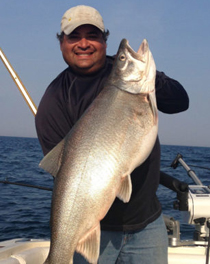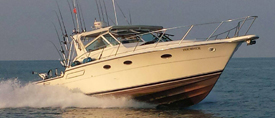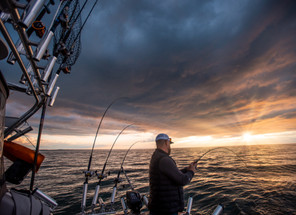Posted by Chris Larsen on 29th Jan 2021
Deep Water Trout & Salmon Trolling
Captain Arnie Arredondo was born and raised in the shadows of Lake Michigan. He grew up in the Kenosha, Wisconsin area and fished for salmon from a wooden boat with his father. Those were the early days of salmon fishing. Gear and tactics were unsophisticated. Lake Michigan and those  who fish the lake have evolved. Arredondo’s Southport Charter Service is based out of Kenosha and he knows the surrounding waters like the back of his hand. He is also a popular seminar speaker throughout salmon territory.
who fish the lake have evolved. Arredondo’s Southport Charter Service is based out of Kenosha and he knows the surrounding waters like the back of his hand. He is also a popular seminar speaker throughout salmon territory.
Arredondo discussed deep water salmon fishing on a recent episode of the Great Lakes Fishing Podcast. “I consider deep water outside of 180 feet. When we talk about deep water, I’m not talking about the surface to halfway down. I’m talking about the bottom 50% or the bottom 30% is what we’re focusing on,” said Arredondo.
His home port of Kenosha is well known for structure. Many Kenosha based anglers rarely venture far from the structure. But as fishing became tougher, Arredondo started seeking out more productive water. “It’s like anything else, you start doing things out of necessity. At different times, groups of fish come in and out, we lose them. While looking for the right water temperature away from the surface, I began to notice a lot of baitfish especially first thing in the morning. When it’s still dark and the sun is just starting to work it’s way up, the graph will tell you a different story than it will once the sun is up… I could see what was going on down below. Necessity is the mother of invention. We had tougher fishing and I was seeing all kinds of bait and gamefish near the bottom... For years I thought anything outside of 150 or 160 feet down was out of range. As time progressed and our fishing got tougher, we started looking for places to catch fish. That’s why I started deep water fishing.”
Kenosha is in southern Wisconsin along the western shoreline of Lake Michigan. As the water temperature in shallow haunts rises, deep water fishing heats up. Arredondo says target species fish move to deep water along with their prey. “We’re doing it more toward the end of July and August. There are three separate groups in the water column. We have the high bait, the medium bait, and the low bait. Once we get to late July and August, the bait that we see near the surface is small, this year’s hatch. In the middle is a mixture of one, two, and three-year-old alewives. At the bottom is the two, three, four, and five-year-old alewives, the much larger ones.”
 One of the biggest challenges to fishing deep water is getting lures down to the fish. “Once you get below 100 feet, I’m basically targeting them with downriggers and a couple of wire divers. I know it sounds funny but with a larger diver, you can get it down to 180 or 190 feet. It obviously takes a lot of line and I primarily use wire. It’s a limited spread for multiple reasons. We’re dealing with a current that’s pretty hard to read down there. That causes a lot of issues as far as tangling. And second, you’re limited to how many lines you can actually get down there with how many riggers you have and your divers. The divers add to the equation because if you’re willing to put a wire diver out with four or five hundred feet of wire, you’ll attain those depths.”
One of the biggest challenges to fishing deep water is getting lures down to the fish. “Once you get below 100 feet, I’m basically targeting them with downriggers and a couple of wire divers. I know it sounds funny but with a larger diver, you can get it down to 180 or 190 feet. It obviously takes a lot of line and I primarily use wire. It’s a limited spread for multiple reasons. We’re dealing with a current that’s pretty hard to read down there. That causes a lot of issues as far as tangling. And second, you’re limited to how many lines you can actually get down there with how many riggers you have and your divers. The divers add to the equation because if you’re willing to put a wire diver out with four or five hundred feet of wire, you’ll attain those depths.”
The other big challenge is managing lines. “Assessing the current is the first step. I typically start with my chute rigger. I get it down and get a reading on what the current is. A great tool that’s definitely a time saver and an anger management tool is a probe to get temperature and speed at the ball. Fish Hawk has a great one… that’s a huge tool that I use to determine what the current is. That’s my foundational move. I start out with my center rigger. I’m getting my other rods ready but the main focus is getting the direction right. It’s not always possible but typically I like to fish into the current. Once I know the direction of the current and how strong it is, that dictates how many other rods I place.”
Arnie Arredondo is a recent guest on the Great Lakes Fishing Podcast. To listen to the full episode, click the player below or visit the podcast page by clicking here.

